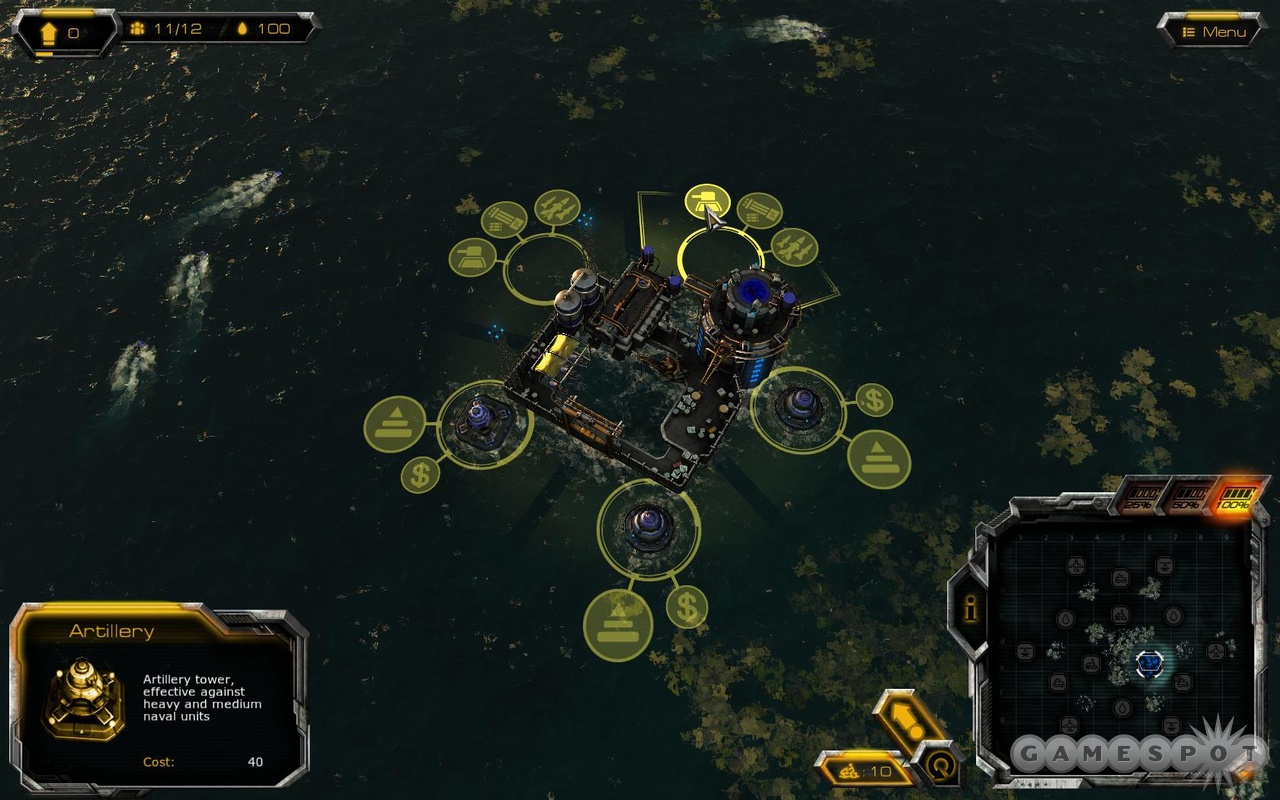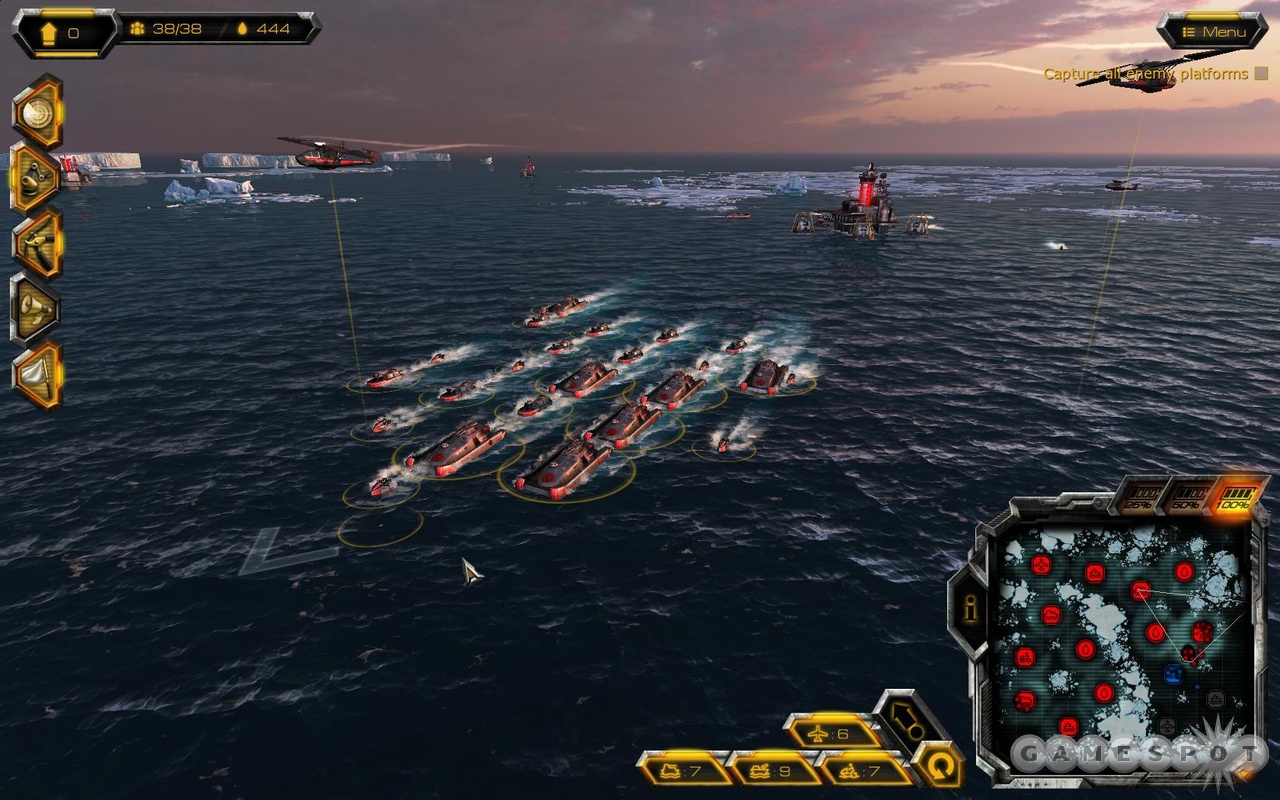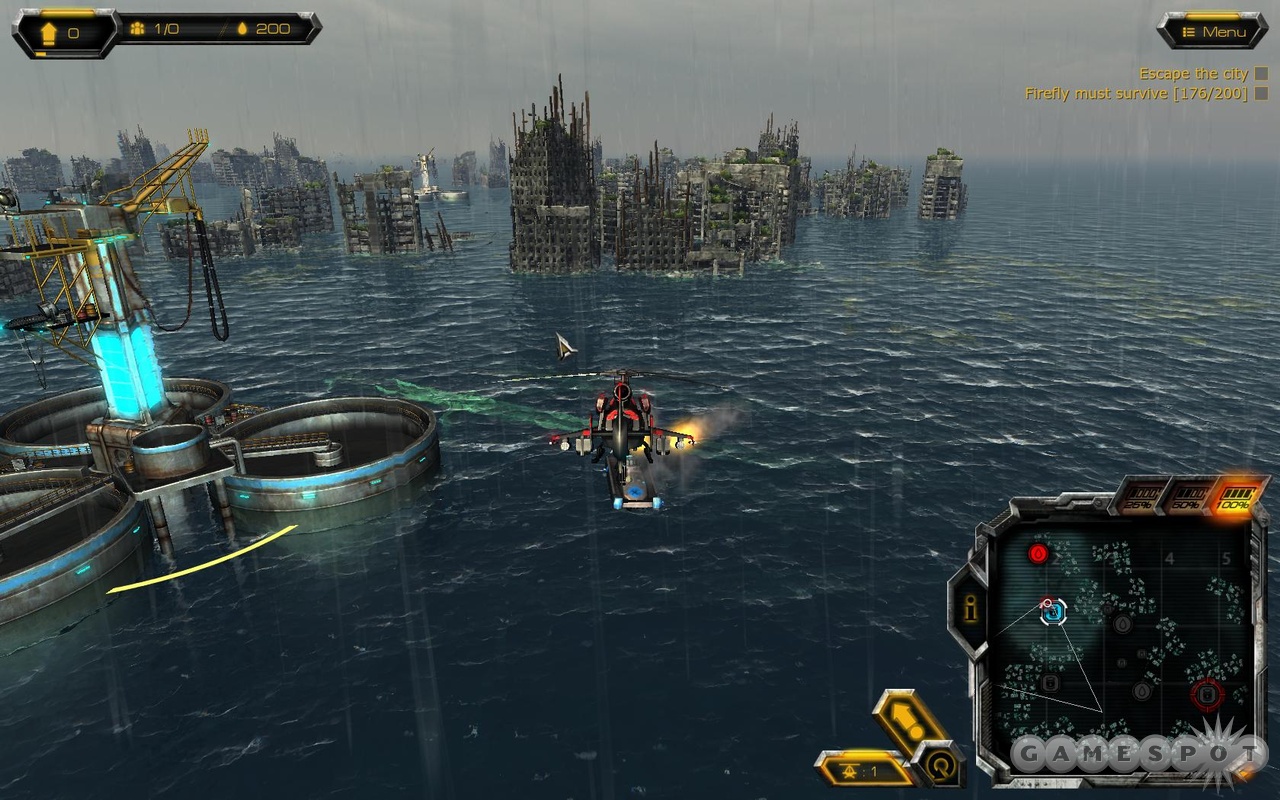Waterworld is a different take on post-apocalyptic life, one where the breakdown of civilization doesn't lead to desolate wastes but instead results in a watery grave. Gaming has largely ignored this sort of apocalypse, but Oil Rush brings such a world to life in a real-time strategy/tower-defense blend. And while it's nice to see a game venture somewhere so distinct, the end result isn't all that different from Kevin Costner's flop. It's interesting and somewhat diverting, but this merging of RTS with tower defense doesn't open up as many strategic options as you may imagine it would.
The Earth is awash in water, the effects of global warming melting the polar ice caps. In this world, humanity clings to the few outcroppings of rock that are tall enough to rise above the waves. Yet the most precious commodity isn't land--it's oil. Yes, society still thirsts for the same fossil fuel that caused the downfall of civilization. Oil, you see, is what drives your war machine. Boats, planes, and helicopters are the tools the various factions use to consolidate their control over their territories--and to acquire more oil.
Your faction, The Sharks, is led by The Commander, an aging man whose sunken features bear a striking resemblance to Grand Moff Tarkin. (And they share a similar sinister streak.) Low on oil, The Commander sends you out on raiding missions to secure oil rigs and production platforms to bolster and improve your forces. You start most missions with platforms and/or oil facilities and can kit out platforms with weapons towers. You can use machine guns for small targets, artillery for larger targets, and rockets to knock down copters or planes, but you must assign units to protect oil facilities. Platforms also spawn units, depending on the type of production facilities they contain. Piranhas are jet-ski-like fast-attack units that can swarm foes but are easy to pick off. Angler boats have cannons and provide a greater challenge. Hammerheads look like landing craft from World War II, and these units are fantastic for assaulting enemy platforms. You gain access to other units, such as the stingray helicopter and the barracuda submarine, as you advance through the missions, conquering technology from other factions.
The game's RTS elements consist of sending units to platforms and oil facilities. You click on a platform to assign units, and you can send everything, keep 50 percent behind, or send out just 25 percent to probe a foe's defenses or to bolster another platform's protection (of course, you can send half your forces, and then half again, to attack with 75 percent of your might). You can also deselect a type of unit to keep it behind, which gives you more control over the disposition of your forces. Once you point your forces to the enemy, you have no control over what they attack; you hope that the units take out targets that they are best suited for engaging (such as angler boats firing their cannons at artillery placements or large vessels). You also have a tech tree with a variety of active and passive abilities that can give your units a boost. Passive abilities increase weapon damage, armor, and speed. Active powers can demoralize the enemy, give your units a damage boost, increase construction speed (handy when you're repairing destroyed towers), or call down a strike of napalm to burn your foe.

Oil is important because it powers your platforms and abilities. While you may continue to spawn units (the platforms do this automatically until they hit their limit; it's similar to the creation of AI creeps in multiplayer online battle arena games such as League of Legends), you need oil to build your towers and use your active abilities. You also need oil to upgrade your towers. Fortunately, most maps have plenty of oil rigs and storage facilities for you to conquer, though on some maps, the strategy focuses on managing your forces with limited oil--or no crude at all.
The game quickly develops a rhythm as you set out your forces, pull some back for defense, or balance out your defenses. The pace of the enemy's attacks is less of a rush and more of a steady stream, though this changes on some levels. A few of the missions provide strategic twists as well, where you have to shepherd your smaller force through mines as an overwhelming force pursues you or hold out against waves of enemy forces in a more traditional tower-defense stage. But on other missions, enemy reinforcements appear from off the screen, even after you've captured all of their production platforms. It really stinks to find yourself fighting off forces after taking all of the production facilities. And one mission proves the futility of most escort scenarios: you escort civilians in Chinese junks away from your vengeful mentor after a betrayal. In this case, the junks stop at every platform on your escape path, unfurling their sails. Why do they stop? It makes no sense for them to stop, especially if they're trying to evade a well-equipped foe--other than to provide an artificial challenge.

The game's voice acting, frankly, stinks. The characters rarely convey the proper sense of urgency (one actor reads her lines calmly even in the most intense situations), and the appalling accent of a Chinese character may turn off some players. After two updates, the game still crashes sometimes, and your video settings occasionally reset when you start the game.
Multiplayer is both the most attractive and disappointing aspect of Oil Rush. It has 15 maps, with some allowing you to face up to three other players (this can be a combo of human and AI players). Many of the maps have interesting layouts, such as a two-player scenario that puts oil resources in protected covers. Another fun map lacks aerial forces, and still another map is an arctic maze that makes it difficult to navigate large fleets. Good luck, though, finding people to play with: the online community, like Oil Rush's world, is somewhat desolate at this time. But you can still play these maps with AI foes, and many of them are more fun than replaying missions from the campaign.

Oil Rush's artists nail its watery setting. Crumbling skyscrapers and rusting bridges jut out of the sea on some levels, and in others, you can see civilization's remains underneath the waves. The platforms look like motley collections of girders and concrete; some of the vessels look like slapdash barges with guns thrown on them; and floating villages and other habitations hint at the misery of a postapocalyptic existence. The art direction sets the mood well, and the visuals look sharp, even at lower settings.
The fusion of real-time strategy gameplay with elements traditionally associated with tower defense make Oil Rush an original game, but unfortunately it doesn't mold its novel concept into a consistently enjoyable experience. An uneven level of tactical depth and some boring missions are glaring flaws, but there's still some fun to be had in this watery world.